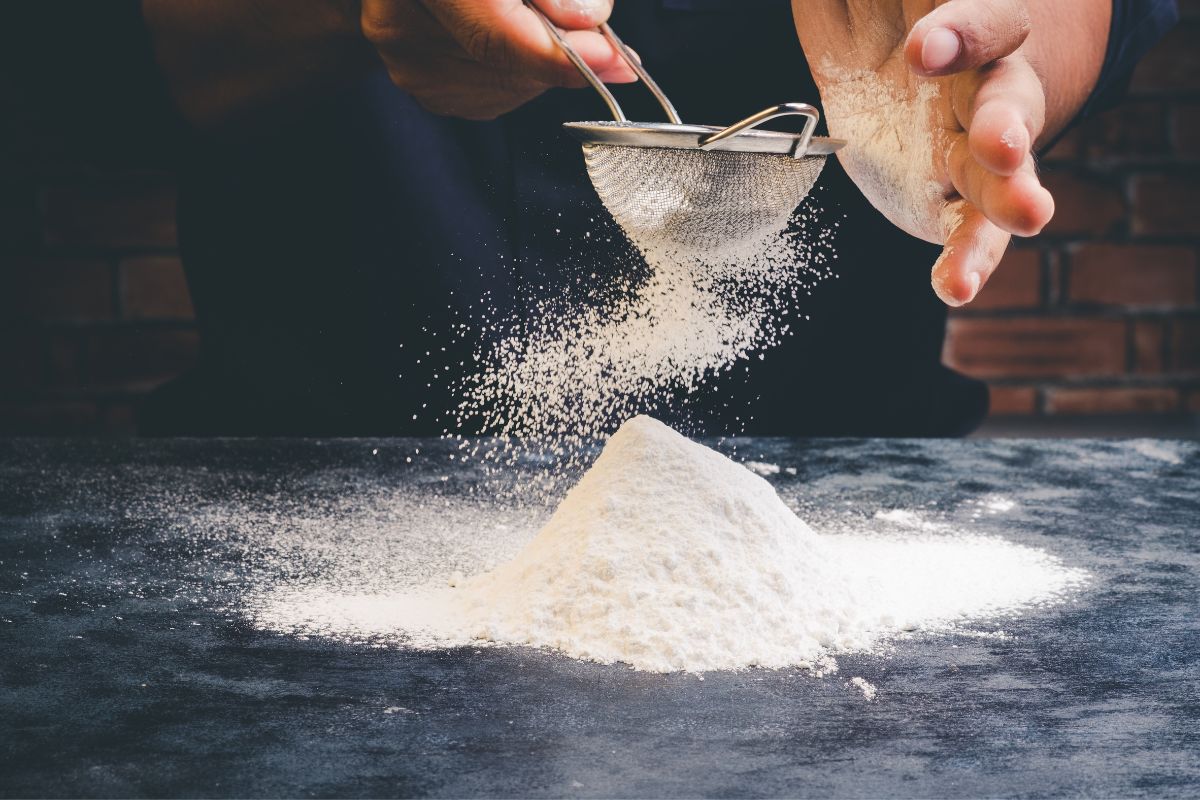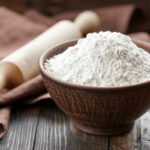Sifting flour without a sifter is possible but how well it works will depend on which method you use and what your recipe calls for.
Choose between a sieve, whisk or a fork and learn how to sift flour without a sifter.

What Is A Flour Sifter?
A flour sifter is a stainless steel kitchen utensil that looks like a large mug. It has a handle and a fine mesh base that the flour passes through when sifted. These are the more basic flour sifters.

Traditional flour sifters have a crank handle that attaches to a scraper on the bottom of the sifter that moves the flour through the mesh.
More modern versions of a flour sifter have a trigger on the handle that moves blades back and forth in the base which pushes the flour through.
What you get when you use a flour sifter is a fine flour which has been aerated and with no lumps. Sifted flour can be used immediately or stored in an airtight container for later use.
When Do You Need To Sift Flour?
Some recipes call for the flour to be sifted and in these cases this can be either before or after measuring. It is important to read the recipe carefully and determine which method is being instructed.
For example, if your recipe asks for a ‘cup of sifted flour’ then you need to sift the flour before measuring. But if the recipe states ‘a cup of flour, sifted’ then you measure out the flour first and then sift it.
Sifting removes any lumps in the flour and allows air to be incorporated into it as it passes through the mesh. This means that the flour is easier to mix with other ingredients and that you will have a light and airy batter
When you are combining a few dry ingredients together, sifting them ensures that the ingredients are properly combined and equally distributed throughout the mixture.
How To Sift Flour Without A Flour Sifter
Flour sifters were originally used to remove and separate parts of the husk from the flour. This was before flour was so well refined and there would occasionally be elements in your flour that you didn’t want.
Today we sift flour for different reasons but still need a method of doing so. The easiest way is with a dedicated flour sifter but if you don’t have one there are other ways to sift your flour.
If your recipe asks for sifted flour, and you don’t have a sifter what can you use instead?
Well there are ways to sift your flour without this specific kitchen tool. Let’s take a look at three ways you can sift flour without a sifter.
Sieve
A fine mesh sieve is an ideal way of sifting your flour if you don’t have a flour sifter. It mimics very well what the flour sifter does, although it requires you to be a little more exact.
To use a sieve for sifting flour, measure out the amount that you need. Position the sieve over a bowl and put the flour into the sieve.
You can now either gently shake the sieve back and forth or tap the side of the sieve gently with the heel of your hand to encourage the flour to move through.
Depending on the size of the sieve you may need to work through the amount of flour in batches.
You can also sieve the flour onto some parchment paper if you need to add it to your bowl a little at a time.
Whisk
If you don’t have a flour sifter or a sieve it is possible to use a whisk to sift flour. When you need to aerate the flour, put it into a mixing bowl and use the whisk to fluff it. This will get air into the flour before you add your wet ingredients.
When you are mixing various dry ingredients together you can use a whisk to blend them together. Put all the ingredients into a mixing bowl and use the whisk mixing them together until they are well combined.
Use a hand whisk to sift flour in this way as an electric whisk will be too much and cause the flour to fly out of the bowl.
A whisk is an alternative way to sift flour but will not work as effectively as a sifter or sieve.
Fork
When you don’t have a flour sifter, sieve or a whisk the only other option is to use a fork to sift flour.
This will incorporate some air into the flour but will require more energy to sift flour this way. If you are using unsifted flour a fork will not be able to remove any impurities in the flour.
When you combine dry ingredients into your flour you can use a fork to mix them together. You won’t be able to distribute the ingredients as well as you would with a sifter or sieve, however.
Sifting Vs Whisking
Sifting and whisking will both introduce air into your flour. However, using a whisk will take more energy to achieve this.
A sifter and a whisk will also differ in how effectively they combine dry ingredients in a mixture.
Passing flour and other ingredients through a sifter will blend ingredients together very well, and they will be evenly distributed throughout the mixture.
Using a whisk for the same purpose will mix the ingredients together but cannot achieve the same equal distribution.
When you are using flour that is labeled as ‘unsifted’ a whisk will not remove any impurities from the flour but a sifter will.
So sifting and whisking will aerate your flour and combine ingredients but will do so to different degrees.
In Conclusion
Sifting flour without a flour sifter is possible and can work quite well to both aerate flour and mix dry ingredients together.
We hope you have enjoyed this guide to sifting flour without a sifter.
- How To Reheat A Cheesesteak - November 5, 2023
- What Are Three Must Have Kitchen Knives? - September 22, 2023
- How To Protect Edges Of Pie Crust - June 15, 2023








